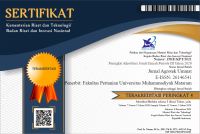Analysis of grain and rice prices in the rice milling supply chain in pengadang village central lombok regency
Abstract
The threat of rice price inflation is increasingly having an impact on Indonesian society, especially the poor, both rural and especially urban. Several expert reviews state that the problem of rice prices continuing to rise is due to increasing rice consumption due to population growth which is not in line with the increase in rice production capacity which continues to decline, one of which is due to the conversion of agricultural land. Rice production in Central Lombok in 2020 reached 314 327.90 GKG or the equivalent of 21.6% of NTB province's rice production. Consumption: Rice consumption for the population of Central Lombok district with a population of 947,488 people multiplied by the rice requirement of 140 kg/person/year is 132,548 tons of rice per year from rice production of 178 103 tons or a surplus of 45,555 tons. However, the rice surplus condition was unable to withstand rice price inflation in early 2024, until it reached IDR 18,000 per kg. Pengadang Village, Central Praya District, Central Lombok Regency is one of the villages with the largest number of rice mills on the island of Lombok, with 10 units and has been a supplier of Bulog rice and some of it is traded to the islands of Bali and Java. This research aims to determine the difference in prices of grain and rice in the rice milling supply chain in Pengadang Village, Praya Tengah District, Central Lombok Regency. The research method uses percentage analysis of price differences and the factors that influence it. The research results show that the lowest supply chain profit is at the price of GKP grain in Merchant at 0.26% or Rp. 20/Kg GKP, and the highest profit in the GKG grain supply chain at the mill is IDR 495/Kg or the equivalent of 6.27%. The rice price profit in the rice milling supply chain is IDR. 30/Kg or equivalent to 0.30%, but there are other benefits from by-products in the form of fine bran and coarse bran amounting to Rp. 1,219/Kg GKG or the equivalent of 12.19%. The yield of GKP grain into GKG is at an average of 84.0% and the yield of GKG to rice is at an average of 64.02%, so that a rice price of IDR can be achieved. 16,000/Kg in the milling unit.
Keywords
Full Text:
PDF (Bahasa Indonesia)References
Ahmad Rifa’i. (2016). Faktor Penentu Harga Gabah Kering Panen di Tingkat Petani tahun 2005-2010. Jurnal Inovasi, 1(1), 57–74.
Aris Munandar, M., Jaya, R., Studi Teknologi Industri Pertanian Jln Tgk Hasan Krueng Kalee No, P., Darussalam, G. G., Aceh, B., Pengkajian Teknologi Pertanian Aceh, B., & Panglima Nyak Makan, J. (2020). Analisis Struktur dan Nilai Tambah pada Rantai Pasok Beras di kabupaten Aceh Timur. Jurnal Teknologi Dan Industri Pertanian Indonesia, 12(02), 49–56. https://doi.org/10.17969/jtipi.v12i2.17014
Djibran, Yasin, Ayu Indrianti, Gobel, & Suhairin. (2023). Analisis Kepuasan Petani Terhadap Penggunaan Benih Padi Varietas Unggul (INPARI dan MEKONGGA) di Kecamatan Limboto Barat Kabupaten Gorontalo. Agriovet, 6(1), 147–158.
Dwiastuti, S., Maridi, Suwarno, & Puspitasari, D. (2016). Bahan Organik Tanah di Lahan Marjinal dan Faktor-Faktor yang Mempengaruhinya. Proceeding Biology Education Conference, 13(1).
Fathoni; Suhairin, I. W. M. (2023). Analisis Berat Jenis dan Kapasitas Kompos Magot pada Tanah Mengandung Pumice di Pulau Lombok. Jurnal Agrotek UMMAT, 10(2), 186–194.
Galuh Octania. (2021). Peran Pemerintah dalam Rantai Pasok Beras Indonesia.
Ipandi, Ekowati, T., & Roessali, W. (2023). ANALISIS PENDAPATAN DAN KELAYAKAN USAHA PENGGILINGAN PADI MENETAP DI KECAMATAN LAUBALENG, KABUPATEN KARO. Jurnal Litbang Provinsi Jawa Tengah, 21(1), 13–20. https://doi.org/10.36762/jurnaljateng.v21i1.982
Kalsum, U., Sabat, E., Imadudin, P., Agroekoteknologi, P., & A Wahab Hasbullah, U. K. (2020). Analisa Hasil Rendemen Giling dan Kualitas Beras pada Penggilingan Padi Kecil Keliling. Agrosaintifika, 2(2), 125–130.
Kusnadi, N., Tinaprilla, N., Susilowati, H., & Purwoto, A. (2011). Analisis Efisiensi Usahatani Padi di Beberapa Sentra Produksi Padi di Indonesia. Jurnal Agro Ekonomi, Volume 29 No.1, Mei 2011 : 25 – 48.
Maesaroh, Martin, Jayanegara, Aminingsih, & Nahrowi. (2023). Evaluasi Fisik dan Kimia Dedak Padi pada Berbagai Level Penambahan Sekam. Jurnal Ilmu Nutrisi Dan Teknologi Pakan, 21(1), 41–48.
Maulana, M. (2016). Peranan Luas Lahan, Intensitas Pertanaman dan Produktivitas sebagai Sumber Pertumbuhan Padi Sawah di Indonesia 1980–2001. Jurnal Agro Ekonomi, 22(1), 74. https://doi.org/10.21082/jae.v22n1.2004.74-95.
Mustafa, M., Usn Kolaka, M. R., Afa, M., & Kolaka, U. (2023). Number of Seedlings per Clump and NPK fertilization Effect on Growth and Yield of Lowland Rice Based on The Leaf-Color Chart. Agrotech, 8(1), 28–32. https://doi.org/10.31327/atj.v8i1.2024
Nelly, S. (2018). Analisis Faktor-Faktor yang memengaruhi Inflasi Harga Beras di Provinsi Aceh. In Jurnal Ilmiah Mahasiswa Pertanian Unsyiah (Vol. 3, Issue 1). www.jim.unsyiah.ac.id/JFP.
Purba, A., Harahap, G., & Saleh, K. (2021). Comparative Analysis of Permanent and Mobile Rice Milling Business Income in Pematang Johar Village, Labuhan Deli District. In Jurnal Ilmiah Pertanian (JIPERTA) (Vol. 3, Issue 1). http://jurnalmahasiswa.uma.ac.id/index.php/jiperta.
Rachmawati, I. N. (2007). Pengumpulan Data dalam Penelitian Kualitatif: Wawancara.
Rihi Mila, & Adi Sudarma. (2021). Analisis Kandungan Nutrisi Dedak Padi sebagai Pakan Ternak dan Pendapatan Usaha Penggilingan Padi di Umalulu Kabupaten Sumba Timur. Buletin of Animal Science, 90–97.
Suhairin, S. (2020). Evaluasi Kemampuan Lahan untuk Arahan Penggunaan Lahan di Daerah Aliran Sungai Maros Sulawesi Selatan. Jurnal Agrotek Ummat, 7(1). https://doi.org/10.31764/agrotek.v7i1.2352
DOI: https://doi.org/10.31764/jau.v11i2.22458
Refbacks
- There are currently no refbacks.
Copyright (c) 2024 Fathoni, Suhairin, Wahyuni & Indrianti

This work is licensed under a Creative Commons Attribution-ShareAlike 4.0 International License.

 |  |  |  |
| |||
 |  |  |
|
Alamat Kantor












